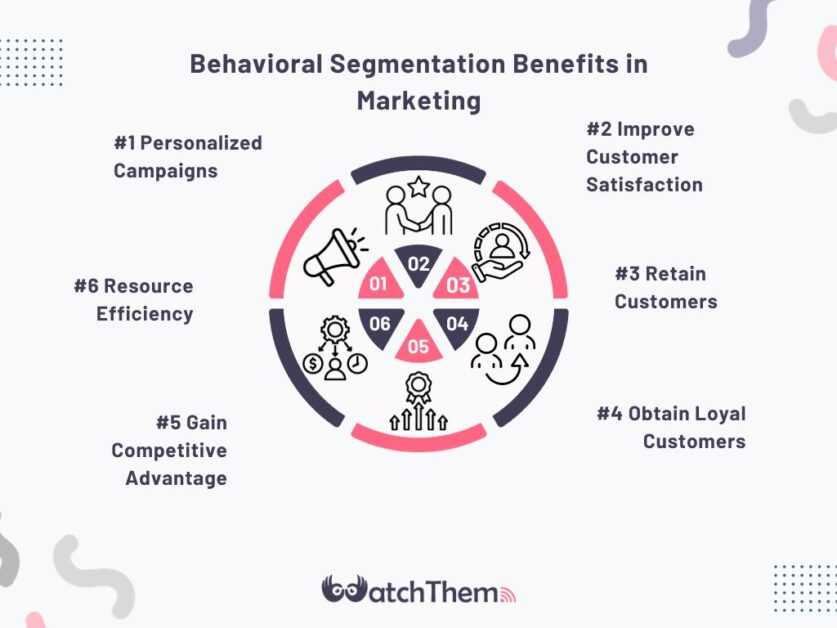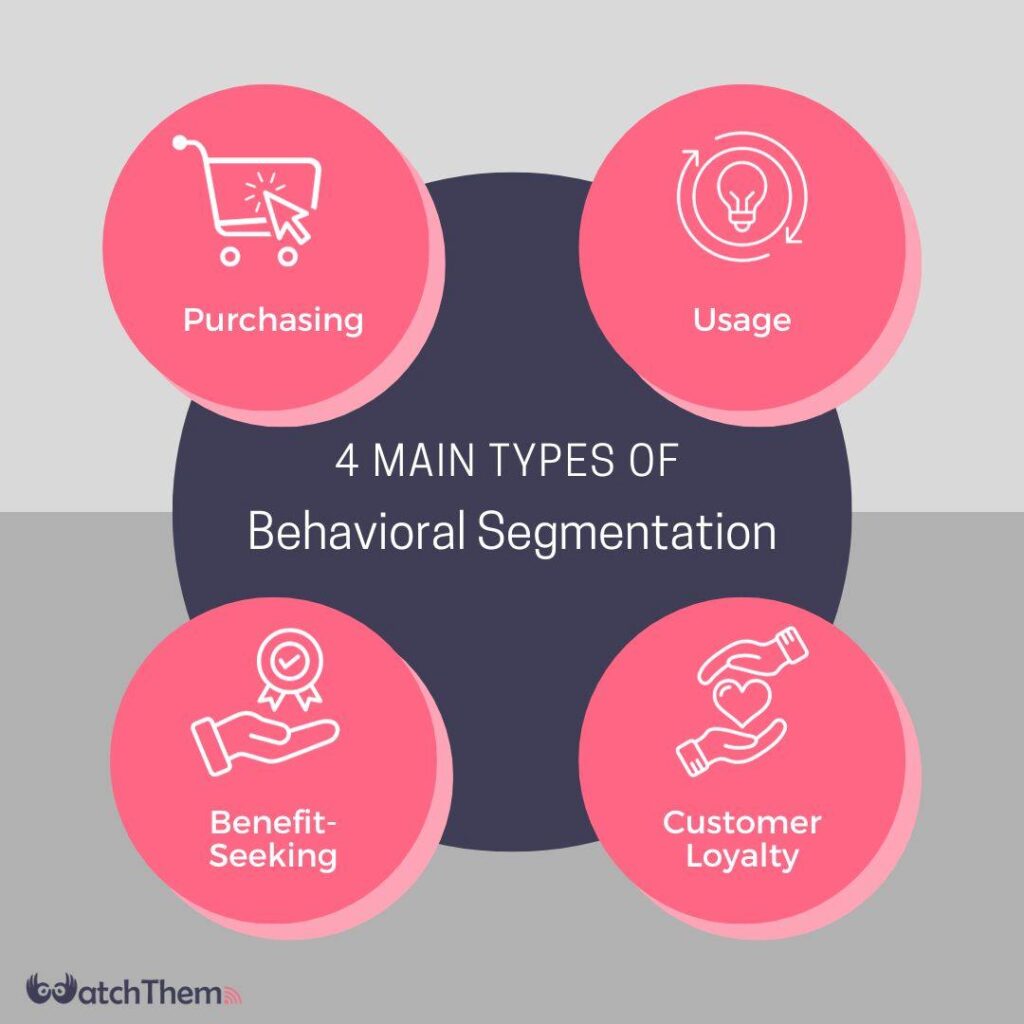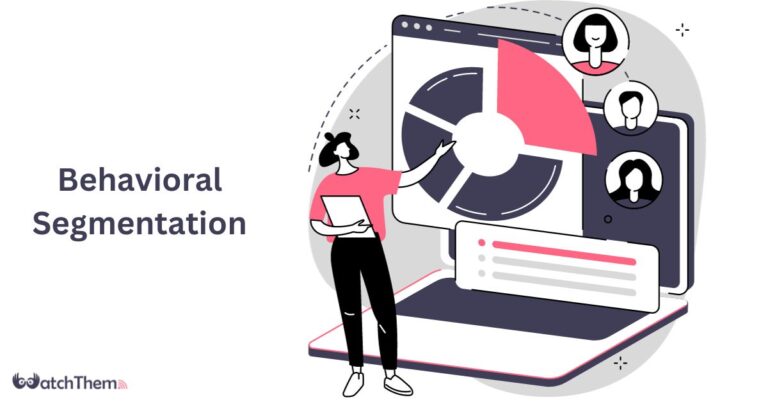Page Contents
Basing strategies on the ‘prediction’ of customers’ responses is a mistake marketers often make. By putting themselves in the users’ shoes, they decide what is best for them without considering users’ different behavioral patterns. That is why many companies use a popular strategy called Behavioral Segmentation that helps them acknowledge customer differences.
Basing strategies on the ‘prediction’ of customers’ responses is a mistake marketers often make. By putting themselves in the users’ shoes, they decide what is best for them without considering users’ different behavioral patterns.
Any growing business will eventually acquire various types of customers, each of whom will have different intentions for interacting with the brand. It won’t be possible to satisfy all kinds of customers with one general marketing strategy.
Therefore, by conducting audience segmentations, businesses will divide their users into different groups based on their similarities.
One of these similarities is the behavior customers exhibit. Do they make purchases regularly or on holidays? Why didn’t they make a purchase? Was it the price?
Observing the customers’ actions and grouping them based on their behavior towards a brand is called behavioral segmentation, which is our topic for today. Now, let’s see what behavioral segmentation definition is and how it will benefit brands.
What is Behavioral Segmentation
Behavioral segmentation is a marketing strategy that businesses use to observe users’ actions and sort them into groups based on their behavior. Behavioral segmentation aims to achieve more efficient marketing for each specific group.
Unlike psychographic segmentation, the behavioral method does not divide customers based on their personality and traits but focuses on customers’ behaviors and actions.
The first step of behavioral segmentation is studying customer interactions and the effects of the customer journey on their actions. Then, each customer will be put into a specific group based on their behavior towards the brand. This process will help businesses run more specific marketing campaigns for each type of target audience and benefit the company massively.
Behavioral Segmentation Benefits in Marketing
Using the same marketing techniques for all users is counterintuitive, as it will be a waste of time and resources and will only be effective for a percentage of the users. Meanwhile, the behavioral market segmentation strategy will allow you to give your customers a more personalized experience.


Here is a list of benefits of behavioral segmentation for your brand:
- Personalized Campaigns: Behavioral segmentation enables highly tailored marketing campaigns targeting specific user groups.
- Improve Customer Satisfaction: You can enhance customer satisfaction by understanding and addressing specific behaviors.
- Retain Customers: Tailoring experiences based on customer behavior increases the likelihood of them staying with your brand.
- Obtain Loyal Customers: Behavioral segmentation helps identify and nurture customers who are more likely to become brand loyalists.
- Gain Competitive Advantage: Using behavioral insights, you can create strategies that give you an edge over competitors.
- Resource Efficiency: It ensures marketing resources are used more effectively, targeting the right customers with the right message.
Implementing behavioral segmentation can result in the next growth spike for your brand. Now that we know the method’s benefits, we must learn about the different groups and types of user behaviors.
4 Main Types of Behavioral Segmentation
By analyzing behavioral data of users’ past interactions with the brand, you can sort them into many types. In the behavioral segmentation method, we divide customers’ behavior into four main types, including:


#1 Purchasing
This type examines how customers act during the purchasing process. It categorizes customers based on their attitudes towards products and readiness to purchase. Purchasing behavior splits customers into five subtypes, including:
- First-time Buyers: Customers recently introduced to the brand could use some suggestions.
- Regulars: By tracking the purchases of regular buyers, we will know when our marketing efforts will be most beneficial.
- Occasional Buyers: These customers show infrequent purchasing behavior but still will make purchases occasionally, for example, on holidays and special events.
- Impulsive Buyers: There is little thought or pattern behind these kinds of customers, and their emotions often drive them.
- Offer Seekers: These customers are mainly motivated to take offers and discounts.
Tracking customers’ purchase behaviors helps businesses tailor their marketing strategies to different types of buyers. Offering home decorations for holidays, reminding regulars to make a purchase, and sending offers to offer seekers are all examples of how behavioral segmentation data can be useful to your business.
#2 Usage
This category focuses on customer engagement and predictions based on their usage data. It involves analyzing customer interaction with a product or service, including usage frequency, time spent, utilized features, the number of users per account, and more. Usage-based behavior subsegments are:
- Heavy Users: Highly engaged customers frequently use or purchase the product or service.
- Medium Users: Customers who use or buy the product semi-regularly, often driven by specific times or events.
- Light Users: Customers with much lower usage or purchase frequency, sometimes only once.
Segmenting by usage allows brands to understand the reasons behind different usage levels and tailor marketing strategies to boost engagement among less active customers and attract potential heavy users.
#3 Benefit-Seeking
Customers with this behavior pattern focus on the specific benefits of products or services. By identifying the primary reasons customers choose a product, companies can align their offerings more appropriately with customer desires and needs. Also, showing the pros and cons of products can help these customers massively.
For example, Amazon shows comparison charts of similar items for their products. This quick comparison will help users make sure about their decision and purchase.
#4 Customer Loyalty
As a form of behavioral segmentation, customer loyalty evaluates how committed customers are to your brand. This can be measured through various indicators such as frequency of purchases, active engagement with marketing campaigns, or participation in the brand’s program.
By focusing on loyalty-based segmentation, businesses can closely understand the habits and preferences of their repeat customers. These loyal customers are not just a source of revenue but are genuinely an asset. They also play a crucial role in promoting the brand by introducing it to their peers and can also provide valuable (and non-scam) feedback.
For example, travel agencies often give their regular clients exclusive benefits such as discounts and special offers. These strategies showcase the importance of recognizing and nurturing customer loyalty.
Best Behavioral Segmentation Examples
Reading about famous brands’ innovations while implementing their behavioral segmentation will definitely inspire you and help you learn from their experience. Here are some real-life examples of behavioral segmentation done by successful brands:
#1 Netflix
Netflix is currently doing one of the most successful behavioral segmentations based on their customers’ usage. By tracking the common types and genres users watch and their time on the platform, Netflix can offer tailored suggestions to its users and hook them to the screen.
#2 Amazon
By analyzing customers’ search and purchase history, Amazon makes personalized product recommendations to customers. Showing information and comparison charts to benefit-seeking users is another top implementation of behavioral segmentation by Amazon.
#3 Spotify
Like the previous companies, Spotify also uses its users’ data, such as their most played genres and artists, listening history, usage patterns, and more, to send them personalized notifications that will most likely prompt the user to open the app.
FAQs about Behavioral Marketing Segmentation
Questions about behavioral segmentation, such as its implementation and main category types, are frequently asked. In this section, we have simplified the answers to these questions.
Q1. How Is Behavioral Segmentation Used In Marketing?
Conducting behavioral segmentation involves a series of 5 strategic steps, including:
- Data Collection: Gather precise data on customer behavior, including purchase history, product usage, and engagement patterns.
- Behavior Analysis: Analyze the data to identify specific customer behavioral patterns and trends.
- User Segmentation: Sort the customers into different behavioral segments based on the behavioral analysis.
- Strategy Development: Develop and implement targeted marketing and engagement strategies for each group of users.
- Monitoring and Adjustment: Continuously monitor the effectiveness of these strategies, adapting them based on feedback and changing behaviors.
Q2. What Are Four Types of Behavioral Segmentation?
Behavioral segmentation includes 4 main types which are:
- Purchase Behavior: Different behaviors exhibited by the customers during the purchasing process.
- Usage: This behavior focuses on customer engagement, interaction, and other usage data.
- Benefits Sought: These customers search for the desired benefits of the products.
- Customer Loyalty: Loyal customers who choose your brand regularly must be targeted differently.
Conclusion – Behavioral Segmentation
Understanding the audience is a necessary part of any successful marketing campaign. By recognizing your customers’ behavioral patterns towards your brand, you can sort them into different groups. This is called behavioral segmentation and is one of the most effective marketing segmentation methods.
When done correctly, behavioral segmentation will increase your marketing efficiency by allowing you to approach specific audiences separately and giving them a much more satisfying personalized experience. Make sure to use it, and your customers will thank you later.

